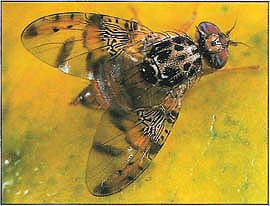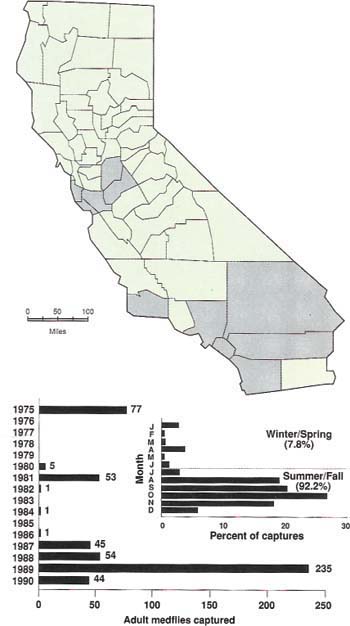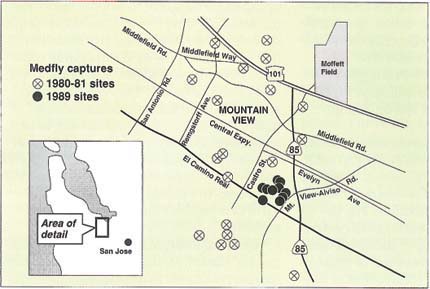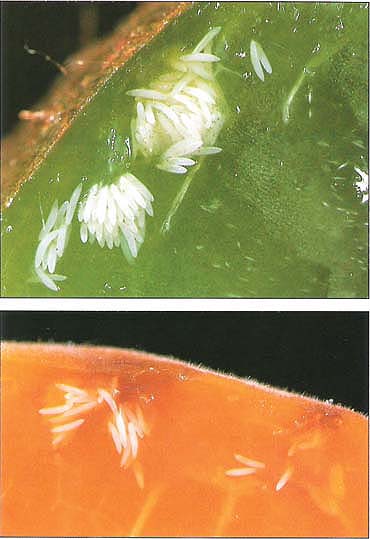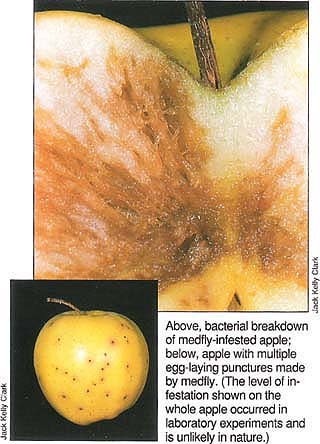All Issues
The Mediterranean fruit fly in California: taking stock
Publication Information
California Agriculture 46(1):12-17.
Published January 01, 1992
PDF | Citation | Permissions
Abstract
Medflies have been captured in California 11 different years since 1975, and every year since 1986. Ten eradication programs have been mounted against this pest at a cost of over $150 million. While considerable scientific debate still exists on the nature of the medfly problem in the state, most agriculturalists agree that the problem is probably long-term. This paper provides a brief historical background of the medfly in the state, reviews existing control technologies and outlines future research needs and directions.
Full text
The Mediterranean fruit fly, (Ceratitis capitata), popularly known as the medfly, is considered one of the worl's most disruptive agricultural pests, and in California it is a major threat to such high cash crops as citrus and stone fruit. It thrives in California's Mediterranean-like climate, forcing growers to meet quarantine compliance requirements before their commodities are allowed to enter such medfly-free areas as Texas, Florida and Japan.
Despite intense efforts to exclude it, the medfly has been captured in California 11 different years since 1975 and every year from 1986 through 1991. The pest has been detected in 13 counties in Southern and Northern California, and 10 eradication programs have been mounted against it at a cost of well over $150 million.
Urban environments in Southern California and along the coast north to the Bay Area provide excellent conditions for medfly introduction, colonization and spread in these respects:
In short, it is difficult to conceive of more optimal conditions for medfly invasions than those that exist in most metropolitan regions of California. Unfortunately, these same conditions also represent the worst situation for successful eradication — optimal climate much of the year, plentiful hosts, complex ecological habitats and movement of infested hosts by people. Couple these conditions with opposition of many urban residents to state-mandated eradication programs, which often involve pesticide use, and it is apparent why the medfly has become a serious issue in California.
This paper is grounded, in part, on results of an in-depth analysis of Southern California's recurring medfly problem. Based on available historical capture and interception data, I concluded that the medfly is established in that region. Arguments for this case have-been presented elsewhere (1991 Science, 253, pp. 1369-1373). Here, I want to present available data as background to the general issue that the medfly threat to California agriculture is real, current, serious and long-term. Specifically, I want to discuss the general consequences for California agriculture if the pest is established, the constraints on several eradication technologies, and future research needs and directions.
Medfly captures in California
The first recorded sighting of the medfly in California was in fall 1975 when 77 were captured in or near Culver City. Less than 5 years later medflies were captured at two different locations 400 miles apart on exactly the same day (June 5,1980) — one male in the city of Northridge in Los Angeles County's San Fernando area and two males in the city of San Jose, Santa Clara County. Later in 1980 a single medfly was captured in San Diego County.
The Northern California infestation eventually resulted in the capture of more than 300 medflies in Santa Clara, San Mateo, Alameda, Stanislaus, San Benito, Santa Cruz and San Joaquin counties. The outbreak treatment area covered 1,300 square miles and included up to 30 aerial malathion sprays in certain cities. Eradication was declared in this $100 million program in fall 1982.
Two medfly eradication programs were also mounted in Southern California — one in the Northridge/Reseda area in 1980 and the other in the Baldwin Park/ West Covina/La Puente area in 1981. These two programs received much less attention than the program in Santa Clara County, but historically they were no less important.
In 1982 only two medflies were captured — one in Hancock Park in Southern California and another in San Joaquin County. For the next 4 years only four medflies were captured in the state — one in Santa Barbara County in 1984 (first record), one in San Diego County in 1986 (second record) and one each in the years 1984 and 1986 in Los Angeles County.
Beginning in 1987, the medfly began appearing in Southern California not only every year but in larger numbers (45 medflies captured that year). That year also marked the first medfly recorded in Orange County. In 1988,54 more adults were captured. A total of 279 medflies were caught in the 1989-90 outbreak, which lasted from July 1989 through November 1990. At least one medfly was captured in all but 1 month during this period, including two female medflies captured 1 week after eradication was declared. First medfly records during this period included those for San Bernardino and Riverside counties. In fall 1989 a small medfly infestation (i.e., 25 adults captured) was detected in the city of Mountain View within a few blocks of where medflies were detected during the Northern California outbreak of 1980-82.
Fig. 1. Map shows counties where medfly infestations have occurred; graph depicts numbers of adult medflies captured in California 1975 to 1990, and percent of captures occurring by month.
The first 1991 medfly capture occurred on October 7. By early December 1991,26 medflies were found — 25 in the Hancock Park/Country Club Park area and 1 female in San Gabriel. Medflies were captured in these same areas in 1989-90. In addition, 1 fly found in Hancock Park was within two blocks of where the single medfly capture occurred in 1982. Ground-spraying and fruit-stripping crews were used in the early stages of this 1991 outbreak and a sterile release program was initiated the first week of December.
Effects of medfly establishment
One likely effect of the permanent establishment of medfly in California would be a shift in the goal of the California Department of Food and Agriculture (CDFA) from protecting all citizens from the damage this pest may cause to only protecting commercial crops. This would be accompanied by a shift from a program supported only by the state's general fund to one at least partially supported by funds from affected erowers.
Fig. 2A–D. Locations where one or more medflies were captured in the Los Angeles Basin: A, 1975-81; B, 1982-86; C, 1987-88; D, 1989-91. The first capture of 1992 was a single mature male found in the Orange County city of Los Alamitos near Westminster, January 3.
The short-term cost of combating the medfly would involve growers who fall within a radius of 4.5 miles around a medfly find. To ship fruit from the resulting 81-square-mile region around the find, growers would have to meet state and foreign government-mandated quarantine compliance regulations. These require that all commodities in the area undergo such postharvest disinfestation treatments as cold treatment or fumigation or that orchards be subjected to pesticide applications every 7 days if the fruit is susceptible to medfly attack. Growers would be exceedingly vulnerable at this stage because of the unpredictability of fly finds and the extensive boundaries defining quarantine zones. These boundaries may include the entire crop of some growers.
If the medfly spreads over a broad region, such as the Los Angeles Basin, an exterior quarantine would be imposed on the area by importing states or countries. This could conceivably be the case if widespread outbreaks of the medfly occurred over a number of years and importing countries began to view the entire region as posing high risk. All growers throughout the region would be required to meet quarantine compliance regulations.
If the medfly spreads statewide, its numbers and the damage it would cause to crops would vary greatly among the state's different climate zones. Based on regions in the Mediterranean that are climatic analogs of parts of California and where the medfly is a pest, it is likely that the medfly threat of direct damage (as distinct from the economic impact of quarantine regulations) is probably highest in Southern California and in the southern San Joaquin Valley. This region includes Imperial, Orange, Los Angeles, San Diego, Ventura, Riverside, San Bernardino and Santa Barbara counties as well as Kern and possibly Fresno counties. Areas where direct medfly damage would be likely to be somewhat less but still at economically important levels would include counties along the Pacific Coast north to the Bay Area and those in the central and northern parts of the San Joaquin Valley and in the Sacramento Valley. There is a chance that the medfly could survive in coastal areas north of San Francisco inasmuch as the pest is present in southern France which is at the same latitude as Portland.
A detailed economic analysis would have to consider the medfly's impact region by region and commodity by commodity, while taking into account its biology and ecology. Affecting its economic impact would be: (1) the duration of freezing temperatures in a region, one of the main factors limiting the pest; (2) ongoing chemical control programs directed towards pests that could suppress medfly populations; (3) an early spring medfly appearance that would determine whether an early maturing variety (for example, apricot) may be threatened; and (4) market destinations that would affect the quarantine status of the commodities shipped.
Eradication tools, strategies
Because no pesticide would be accepted by urban residents for widespread and repeated applications, the greatest challenge facing researchers today is to develop an alternative to insecticide use. It would have to be an equally effective, nonintrusive alternative to an eradication strategy which has involved repeated (7 to 12 times) aerial applications of malathion pesticide over areas of several hundred square miles. This research challenge is formidable because of the nature of eradication. To develop a technology that is effective in decreasing population growth or knocking down medfly populations to low levels is different than one to reduce a medfly population to zero over the entire Los Angeles Basin. That goal, up to now, has characterized every eradication program ever mounted in California.
Fig. 3. Locations where one or more medflies were captured in Mountain View, California in 1981 and 1989. Mountain View was one of approximately 30 cities in which medflies were captured during the 1980-82 outbreak in Santa Clara County. It is the only Northern California city in which medflies have reappeared in recent years.
Photos show medfly eggs in kiwi (above) and apricot. (These photographs were taken during laboratory experiments and not in the natural setting. While apricot is known to be a preferred host of medfly, kiwi is not.)
Various options are available for dealing with the medfly including newly developed ones. Some tactics hold little promise, but it is useful to discuss briefly the reasons why.
Biological control. No record exists of any insect population ever being eradicated using parasites and predators alone. There is no evidence that the medfly would be an exception to this, inasmuch as no medfly parasites exist in the Mediterranean regions of Europe where the pest is widespread. However, several tropical fruit fly parasites are being evaluated by the U.S. Department of Agriculture in Hawaii, Mexico and Central America in the hope that mass releases of such agents could eventually augment the effectiveness of the sterile insect technique. For this option to be viable, however, the effectiveness of the parasite against the medfly would have to be demonstrated under California-like conditions.
Ground spraying and fruit stripping. Logistical problems impede the effectiveness of both ground spraying and fruit stripping. Two-person ground crews using backpack sprayers can treat an average of 30 to 35 properties per day under ideal conditions (i.e., complete owner cooperation, optimal weather, etc.). A total of 70 to 80 two-person crews are needed to treat a single square mile containing 2,500 properties in 1 day, or 5 square miles in a 5-day work week. Treatments are then often repeated every 10 days for several months. The logistics of ground spraying are overwhelming when an infestation covers several hundred square miles. The number of persons required to strip fruit over a large area is even more staggering. A five-person crew can strip 10 to 15 properties per day, on average. Therefore 150 to 250 crews or about 1,000 workers are needed to strip a single square mile of urban properties of fruit in 1 day. If you multiply this by several hundred square miles and multiple visits per property as new hosts mature, it becomes apparent that fruit stripping, like ground spraying, is not a viable option for large-scale eradication.
Sterile insect technique (SIT). The underlying concept of SIT is simple — inundate the wild population with steriles. The sterile males then mate with wild females and the population goes extinct due to the shortage of fertile eggs. However, application of the technique is enormously complicated by having to decide what constitutes a “high quality” fly and by a lack of scientific understanding of how many flies to release per square mile. No record exists of a medfly population being eradicated using sterile flies alone; malathion sprayings have always preceded sterile releases. For example, the successful sterile release program in Mexico, which stemmed the northerly spread of the medfly from Central America, required 60 aerial applications of malathion before sterile flies were released.
To take full advantage of this technology, a number of questions must be addressed by researchers about SIT: Is this technology capable of eradicating a medfly population? If so, under what sets of conditions? Do sterile flies actually affect the target population's growth rate through sterile male matings or by some other factors such as mass confusion (i.e., wilds of each sex simply not finding each other)?
Above, bacterial breakdown of medfly-infested apple; below, apple with multiple egg-laying punctures made by medfly. (The level of infestation shown on the whole apple occurred in laboratory experiments and is unlikely in nature.)
Mass trapping and killing stations.
The response of medflies to attractants and color panels in the killing station approach may not be sufficient to curb population growth over a long period — the condition needed for ultimate eradication. Most fruit fly entomologists agree that the attraction of medflies to existing lures, such as trimedlure or ceralure (one of its chemical variants), would have to be improved at least 20-fold before it would be comparable to the methyl eugenol attractant/oriental fruit fly system. The U.S. Department of Agriculture is conducting research in Guatemala to analyze the effectiveness of the male annihilation/mass trapping technology against the medfly. Trials using yellow panels coated with a sticky substance and the male attractant ceralure (after Ceratitis) and trimedlure have been inconclusive.
Biological insecticides. Most insect pathologists agree that no insect viruses or fungi under study show potential for medfly control. However, for the past several years USDA scientist James Lindegren in Fresno has conducted research on a nematode that holds promise. This nematode, Steinernema carpocapsae, has been highly effective against lepidopterous pests (for example, pink boll worm). However, it would have to be applied in higher doses to kill flies such as the medfly. Nematodes are viewed as a possible alternative to the use of diazinon soil drenches beneath infested trees but not as an alternative to the malathion used in the bait to kill adults. Two biological problems inhibit the effectiveness of this parasite against the medfly: (1) Its most efficient time for attack is immediately after medfly larvae leave infested fruit to pupate. This period is relatively short. (2) It persists only 1 to 2 weeks in the soil. Therefore multiple applications are required to maintain high kill rates and the cost for use on a large scale may be prohibitive.
In addition, preliminary research at UC Riverside by Brian Federici suggests that it may be possible to isolate a strain of the insecticidal bacteria Bacillus thuringiensis (Bt) that will kill adult medflies. The Bt strain would be used in conjunction with a killing station or possibly in localized bait sprays similar to the current use of malathion. It is estimated that research and development on a Bt strain effective against the medfly in the field would require at least 5 years, even if intensive studies start immediately and a suitable strain is found.
Basic research needs
Although the most pressing research objective is perceived as developing alternatives to the aerial application of malathion, much basic work is also needed. The following is a list of areas where, I believe, research is needed.
Medfly biology and ecology. Despite intense research over several decades, there are major gaps in knowledge of the medfly's basic biology and ecology, particularly as it exists in the Mediterranean where the climate is like California's. Information is needed about: (1) how the medfly overwinters in subfreezing conditions as are sometimes found in both the Mediterranean and California; (2) preferred medfly hosts in the Mediterranean; (3) the medfly's natural enemies as well as why no medfly parasites exist in the Mediterranean; and (4) a detailed map of the medfly's distribution in the Mediterranean as an aid in predicting its distribution and abundance in California---if it becomes widespread in this state. Research is also needed on the population biology of its invasion. Little is known about the early stages of any insect pest invasion---knowledge on this aspect will provide insights into criteria for declaring eradication as well as capture patterns that can help interpret trap catches at low population densities.
Attractants. The sex pheromone of the medfly has been extracted and tested but not chemically identified. Several host-based volatiles have also been identified as moderately attractive to medflies. However, pilot studies examining these substances suggest that they are roughly equal to trimedlure in attractiveness. The advantage of host volatiles is that they attract females to traps, thereby providing information on population structure and age. Female lures are also useful in developing mass trapping technologies because the female is directly responsible for population growth. In general, any search for new and more powerful attractants must be tempered by an awareness of the possibility that the medfly may never respond strongly to any substance. Studies are needed on its foraging and mating behavior as well as analysis of its physiological response to stimuli. These studies will provide insight into the constraints on medfly responses to various attractants and, in turn, perspectives on the limits of its detectability.
Genetic analysis. Development of a genetic library on the medfly would be immensely valuable in answering questions regarding geographic origin of introduced flies, relatedness of flies captured in different regions of the state, and insights into global patterns of invasion and spread. Groundwork for answering many of these questions has been laid by Michael Loukas and co-workers at the Agricultural University of Athens who conducted a genetic analysis of medflies from many regions including Africa, the Mediterranean, Central and South America, and Hawaii. Loukas and coworkers tentatively concluded: (1) the likely pathway for the medfly to the Mediterranean was via the Iberian Peninsula (i.e., Spain and Portugal); (2) medfly populations in Spain appear to be the original source of the spread to the remaining regions of the Mediterranean as well as to South America; (3) little difference exists between Central American and South American medflies, suggesting that they originated from a single introduction; and (4) medflies from Africa and from Hawaii are distinctly different genetically from each other as well as from American and European medflies. Geneticists in Crete and Italy have corroborated many of these results.
These findings imply that it may be possible to determine the source of flies found in California, if the proper steps are taken to preserve them and qualified geneticists are provided access. This information will be useful in developing future policy for medfly exclusion. For example, if it were found that the infestations stem from Hawaii — a point source as well as a U.S. state — then legislation could be passed to deal specifically with the limited number of Hawaiian airports from which air travellers and cargo destined to California originate. The same argument applies to the single postal source in Honolulu that handles all Hawaiian mail. If medfly infestations are shown genetically to be closely related to those found in Central or South America, then dealing with the exclusion problem is more complicated since it would be an international problem and there exist a multitude of source regions. But in either case, exclusion policy would be based on solid genetic evidence of flies captured in the state rather than on incomplete data based on the few medfly interceptions at airports.
A team of geneticists headed by Bruce McPheron at Perm State and funded by CDFA is analyzing medfly specimens captured in 1989 and 1991 to determine geographic origin or at least to eliminate some regions as likely sources. Eventually they hope to extract DNA from preserved specimens captured in the 1980-82 medfly eradication programs, permitting assessment of the flies' genetic origins and their links with other California medfly outbreaks.
Trapping. Two interrelated objectives in medfly trapping exist: (1) to have confidence that no medflies are present when none is captured, and (2) to gain as much information as possible about the population if medflies are captured. For the last case, the single most important piece of information to be learned is their distribution, since a population cannot be eradicated whose distribution is unknown. Obviously a strong attractant is desirable for both objectives.
Additional information that can be extracted from adult captures includes the individual's sex, maturity and mating status. Technology available but not used in medfly infestations includes the ability to determine: (1) host origin (determining the host on which an adult developed as a larvae), (2) geographic origin (genetic analysis), and (3) age (young, mid-age or old). There is also a pressing need for knowledge of local trap placement (within trees and backyards) as well as for re-examining areawide trapping strategies. For example, the Medfly Science Advisory Panel has discussed using a sweep-trapping approach in which each area is intensively trapped for a short time during periods of highest population activity (late summer and fall). This approach could augment standard trapping programs.
Eradication criteria. A troublesome but necessary aspect of ail medfly eradication programs involves deciding the criteria to use for declaring the medfly eradicated. Today's criteria is conditional on the type of eradication technology employed. For example, if sterile medfly releases are used, negative medfly finds for three generations are required to declare eradication. If malathion bait sprays are used, negative finds for two generations are required. In both cases generation times are determined with degree-day models. Because of the seasonality of medfly finds in California (usually summer and fall), much of the degree-day accumulation occurs during winter. Research is needed to determine what constitutes eradication, including effects of seasonality and trap density as well as whether use of degree-day models is appropriate.
Economic impact. No analysis of the economic impact on California agriculture, if the medfly becomes permanently established and widespread, has been published. However, Jerome Seibert, agricultural economist at UC Berkeley, has written a working paper on the issue and provides broad economic estimates. Robert Dowell, CDFA entomologist, has also estimated the potential impact ( see pp. 6-8 , 10-12 ). Most estimates of the economic impact of a permanent medfly establishment in California assume the worst-case situation — immediate widespread medfly distribution and heavy attacks on all potential hosts. There are basically three questions that must be addressed before a comprehensive and in-depth assessment of the economic impact can be made of medfly establishment in California. These are:
Conclusions
Eradication programs have been conducted annually against the medfly in Southern and Northern California for the last 5 years. This should leave little doubt that the medfly threat in California is serious and probably long-term. Research is needed immediately to improve trapping efficiency, to increase knowledge of basic medfly biology and to develop biological insecticides that pose minimal health risk to humans. Also, four steps must be taken to deal with this developing problem:
-
A long-term research program, based within the state, must be developed in collaboration with federal, state and university scientists. The program should include U.S. scientists in other states at risk of medfly invasion (for example, Texas, Florida and Arizona); entomologists in Hawaii, where the medfly is established, and international fruit fly scientists in Mexico, Central and South America, and the Mediterranean. The first step in this direction was taken last year: Funds appropriated by the California Legislature and distributed through CDFA launched a collaborative effort to find alternatives to malathion bait sprays and better medfly attractants. However, a larger and more unified effort must be mounted.
-
Two short-term issues must be addressed immediately. They are: ensuring that all growers and commodity groups clearly understand what constitutes quarantine compliance; and developing criteria for fly-free zones acceptable to importing states and countries. These may be similar to criteria for fly-free zones used by Florida to deal with the Caribbean fruit fly. (For additional discussion of pest-free zones, see p. 10.)
-
Exclusion efforts along entry pathways should be intensified, based on generic analysis of recent medfly finds to pinpoint their origin. Sound exclusion policy for the future must be based on detailed and in-depth understanding of the nature of the introduction problem and not simply on the limited amount of medfly interception data. For example, there have been only 13 confirmed medfly interceptions along potential entry pathways in recent years — 5 at California international airports (San Francisco, Los Angeles and San Diego) since 1985,2 at vehicular border stations from 1974 to present, 5 medfly-infested packages in the U.S. mail and 1 UPS package destined to California from Hawaii. Genetic analysis of medflies breeding in the state will help distinguish potential medfly sources from actual ones.
-
A feasibility study and blueprint for a full-time, multiyear eradication program against the medfly must be developed, using sterile release technology. This could serve as the foundation for a program for the worst-case situation, if or when today's medfly crisis worsens.
The medfly's presence in Southern California is not just a regional problem. Its appearance anywhere in California will eventually affect most of the state's agricultural areas, those of southern U.S. states and the fruit-growing regions of northern Mexico. Agriculturalists, entomologists, administrators and legislators at state and national levels cannot sit still — the developing medfly crisis must be addressed directly and decisively.



